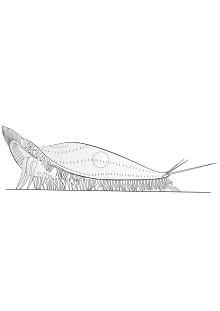Stylonychia
| Stylonychia | |
|---|---|
| Stylonychia mytilus | |
| Scientific classification | |
| Domain: | Eukaryota |
| Clade: | Diaphoretickes |
| Clade: | SAR |
| Clade: | Alveolata |
| Phylum: | Ciliophora |
| Class: | Spirotrichea |
| Family: | Oxytrichidae |
| Genus: | Stylonychia Ehrenberg,1830 |
Stylonychiais a genus ofciliates,in the subclassHypotrichia.Species ofStylonychiaare very common in fresh water and soil, and may be found onfilamentous algae,surface films, and among particles of sediment. Like other Hypotrichs,Stylonychiahasciliagrouped intomembranellesalongside the mouth andcirriover the body. It is distinguished partly by long cirri at the posterior, usually a cluster of three. The largest can just be seen at a 25x magnification, and the smallest can just be seen at a 450x magnification.
Description[edit]


Stylonychiacells are roughly oval in shape, inflexible and flattened from back to front.[1]The organism's cilia are grouped into structures called "cirri," tufts of joined cilia that function together as a unit. The cirri on theventralsurface of the cell can function as legs, enabling the organism to walk along solid substrates, such as submerged algae, leaves or debris.
Like other ciliates of the family Oxytrichidae,Stylonychiahas a prominent group of eighteen large cirri on its ventral surface, arranged into six smaller groups: the frontal, buccal, frontoventral, postoral, pretransverse and transverse cirri.[2]The region around the cell mouth (cytostome) is partially encircled by a series of compound cilia which make up the "adoral zone of membranelles",or AZM. This structure, which resembles the collar and lapel of ajacket,is used mainly to circulate water and brush particles of food into the organism's cell mouth. On the right side of the oral area are two "undulating membranes", delicate scarf-like structures made up of fused cilia. At theposteriorof the cell are three long, stiff "caudal cirri", attached to the body at the lower margin of itsdorsalsurface.[1][2]
Image and video Gallery[edit]
-
Stylonychia putrina
-
Stylonychiaeating (vacuole formation)
-
Stylonychiagrowing a second mouth (stomatogenesis, prior to cell division)
References[edit]
- ^abCaspers, H. (1983-01-01). "Colin R. Curds: British and Other Freshwater Ciliated Protozoa. Part 1. Ciliophora: Kinetofragminophora. = Synopses of the British Fauna (New Series), ed. by D. M. KERMACK and R. S. K. BARNES, No. 22.— With 243 figs., 387 pp. Cambridge: Cambridge University Press 1982. ISBN 0521 242576 (hard covers) 285585 (paperback). £ 27.50/11.95".Internationale Revue der Gesamten Hydrobiologie und Hydrographie.68(6): 899.doi:10.1002/iroh.3510680627.ISSN1522-2632.
- ^abBerger, Helmut (2012)."B Systematic Section Stylonchinae".Monograph of the Oxytrichidae (Ciliophora, Hypotrichia).Monographiae Biologicae. Vol. 78. Springer. pp. 499–.ISBN978-94-011-4637-1.
External links[edit]

